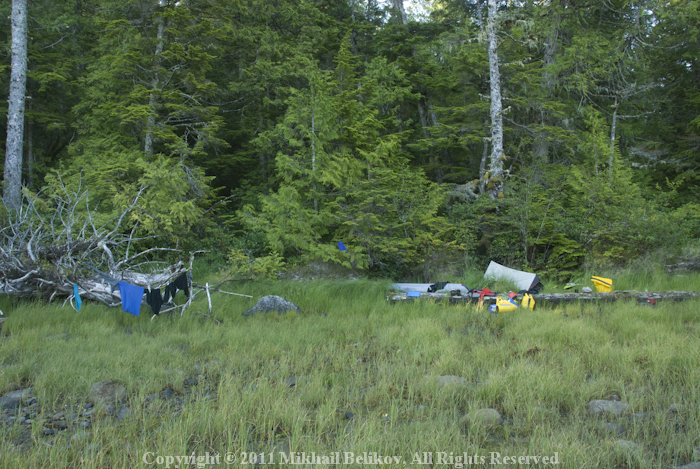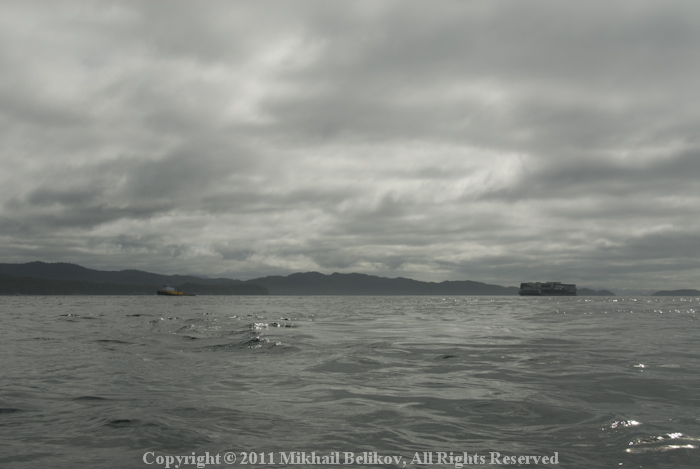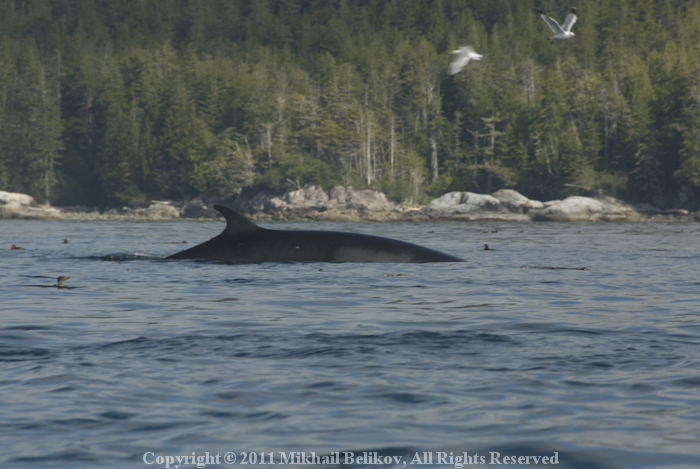The alarm woke me up at 3:00am. Lying inside the tent
I could hear the wind. Stepping out confirmed that the wind
was blowing hard. Realizing that this was likely going to be another
day on the
island, I went back to bed, setting the alarm for 6:30am, just in case
the wind subsided, and had fallen asleep. Something woke me up at 5:00am.
It was
the silence: I could hear
the mosquitoes outside the tent. It took me a second to realize that
the wind
had died. Everything went into the overdrive mode: a quick breakfast,
then an
expedited packing, meanwhile asking the gods of sea to keep it calm for
a few
more hours. It was low tide, and the portages over the expanse
tidal zone
to the water edge took some time, four minutes each way. It did not
sound like much;
however considering that I needed at least six portages to get all my
stuff to
the loading place, around fifty minutes were taken by just this
procedure.

I
had finally departed at 8:30am. It was still perfectly calm in the
channel, but once in the open I
had experienced a light easterly wind and small waves. Still, a perfect
day for
the crossing. I had no issues paddling across Ripple Passage to Miller
Island Group, clearly visible.
On
my way, I had passed small rocky islets, often occupied by birds.
Besides having a chance to take interesting pictures, I tried to plan
my path close to islands and islets to have a place of escape in case of
an accident. Being washed out on a dry rock was still better than
taking my chances in the cold water.
Rhinoceros Auklets claimed the ocean all around me, swimming and
passing by in flocks.
Once
close to Miller Islands, I had started hearing some strange
noise,
like someone
trying to start a boat engine over and over again. It was coming from
an island to the left and could well be the roar of sea lions. When I
came closer, I
indeed saw six Steller Sea Lions lying on the rocky outcrops. I
got close enough for the animals to notice me but not so
close that I would disturb them. After looking at me, the lions had
returned to their
activities: mostly resting on the rock, some moving through the group
that
was loudly objecting to that intrusion. I had taken a number of
pictures before
continuing my journey.

After
passing through Miller Group, I was planning to
take the shortest route to the mainland, crossing Richards Channel to
Jeannette Island just off the continent. However, I saw a tugboat with
a
container barge, still far away but definitely moving in my direction.
The distance was still significant, but based on my
previous experience I knew that these tugboats were faster than they
looked, and
I had decided to let it pass.
Instead
of waiting, I had started paddling parallel to the barge along Millar
Islands, heading south-east, and by the time the barge had passed I was
already beyond the last island. Then I had turned and began crossing
the
channel, aiming at Stewart Point on the mainland, as I was already too
far east to cross to
Jeannette Island. The sea was definitely
calming down and this was a pleasant crossing. Less than a kilometer
from the shore, I saw
a large number of birds in feeding frenzy and came closer to
investigate.

A whale or a group of whales was feeding on a school of
fish, likely forced in a tight ball close to the surface where the
birds
were
helping themselves to the easy meal. I kept myself a couple of hundred
meters
away, as the whale was disappearing for extended periods of time and I
was not
sure where it would surface next. My preference was to be a spectator,
not part
of the show.
Then, after a few dives, the whale had surfaced relatively
close.
It was certainly a warning sign that I should paddle away.
Meanwhile, the wind had died and the sea calmed down
completely. Rhinoceros Auklets were floating around me, in small to
medium size
flocks, frequently diving.
I
took a few more pictures of the humpback whale surfacing
among the gulls in feeding frenzy, too far for a good shot, but the
safety
first, mine and the whale. I then observed an interesting behavior: a
bird,
not unlike a frigate bird, dark in color
but smaller in size, with at least one long tail feather, was harassing
a gull, like a frigate bird would do, until it dropped a fish.
Unfortunately for the harasser, another
gull had picked up the meal and then the dark bird had flown away.
Everything
happened too fast to take a photograph.
Later I had learned that this was likely a jaeger.
After photographing the gulls and the auklets for a
while, I had continued to Stuart Point. Meanwhile, I was feeling more
and more
uncomfortable in my kayak. Since I had to depart in a hurry, I did not
pack the
kayak tight enough and the lack of space inside was becoming painful
for my
legs. I had decided to stop for a quick lunch at Marsh Bay, just behind
Stuart
Point, and move the dry bags around to make more space for my legs.
After
paddling around the bay, quite shallow in some areas, I had found a
small
pebble beach and landed there. Unfortunately, the surf, although light,
kept
pushing my kayak on the shore, and I had to eat staying in water and
keeping the
kayak afloat. The changes in the placement of dry bags had slightly
increased
the legroom inside the kayak, and I continued paddling in more comfort,
enjoying Vancouver Island views across Queen Charlotte Strait.
It
was hard to believe that I had crossed such an expanse of water.
Fortunately, I had done it in a safe way, in several leaps with rest
& refuge points between.

A little creek was shown on the chart, inside a small bay
on my way to Robinson Island. I had stopped to refill my water
containers but
did not find the creek. Continuing to the intended campsite on Robinson
Island,
I had started looking for a narrow passage between this two
kilometer-long island and
the mainland. It was shown as drying at low tide and I hoped that it
was still
passable. Taking the passage would have saved me some time, and I was
already getting
tired after a long paddle. Unfortunately, the passage was dry.
Moreover,
through the passage I saw a power boat inside the bay. The bay was
marked with
an anchorage sign on the chart and I had realized that my stay there was not going
to be as
secluded as I had hoped. A sailboat with a dinghy in tow had passed me
and
turned into the bay, confirming my expectations. Soon, I had also
reached the bay entrance.

After entering the bay I had started looking for the small tidal area
where I intended to camp.
I had found it shortly. The tidal area was actually quite large, as low
tide had
exposed vast space.
I had checked the shore for a flat spot above the high tide,
large enough for my tent. Same as at my previous campsite, I had found
several
little patches of wet grass, likely flooded at very high tide. I had
selected
the biggest one, flat and just big enough for my tent. Unfortunately,
it was
slopped, but nothing else was available, so it would have to do for a
night.
I had unloaded my kayak very fast, as while I was looking
for a camp site it got deposited by ebbing tide on rocks overgrown
with
nasty-looking sharp barnacles. I had checked the kayak
bottom thereafter:
no damage except a few short cuts, up to half-way through the skin. I
had
filled them with the glue thereafter.
It was hot: no wind in the bay and the sun was in full
force. After placing my kayak on the shore, I had to cover it with
everything
available, including my sleeping bag, its inner cotton side up, and the
cotton
insert, to protect
from the UV
rays and overheating. The blazing-hot sun had induced me to take a bath
and
wash my clothes. The water was surprisingly cold and I hesitated for a
while.
Meanwhile, two more boats had entered the bay, a sailboat and a
powerboat.
While I was hesitating, the wind had picked up and it suddenly was not
that hot
any longer. Never the less, I had bravely washed myself and then my
clothes,
and hung them to dry.

This was my first pasta day. I had mixed fresh and sea
water, in the 3 to 1 proportion, and started cooking a double portion
of pasta.
While taking care of the tent, I heard some metal noise in the cooking
area.
Sure enough, the pot was on its side, with half of the pasta on the
ground.
Maybe I did not balance the pot on the stove well enough, or maybe it
was the
wind. This had reinforced the important rule to never leave the cooking
food
unattended. Fortunately, the pasta was already fully cooked, so I used
what was
left in the pot for dinner. I had collected the rest, washed in the sea
water
and left for the next day, to be consumed after a quick disinfection
boil.
After packing up for tomorrow I went to bed at around 10:00pm.














